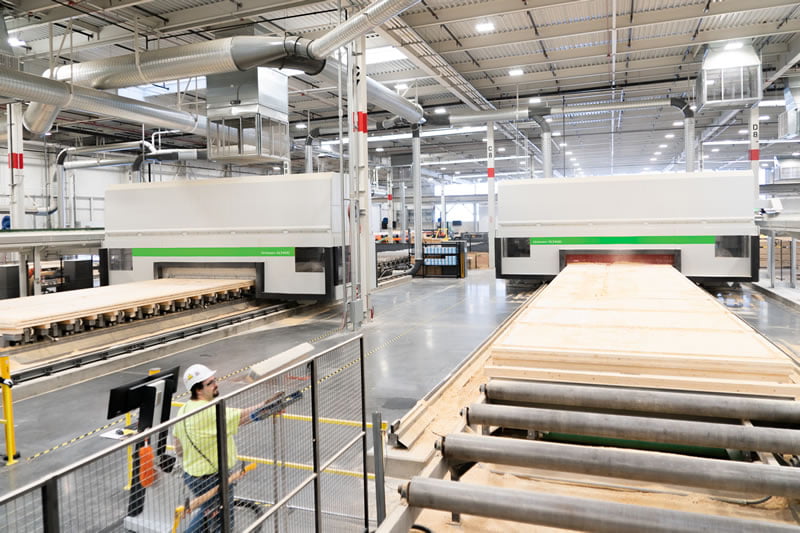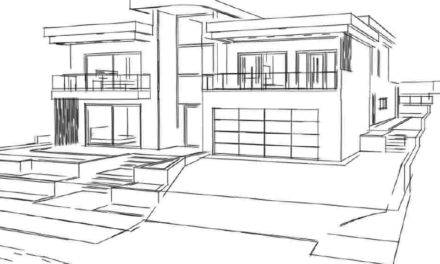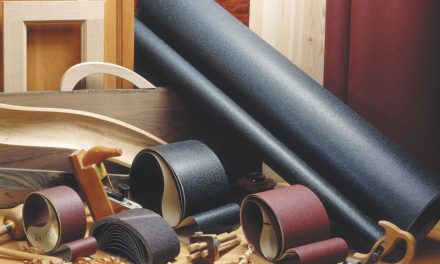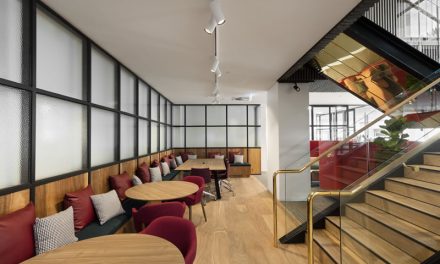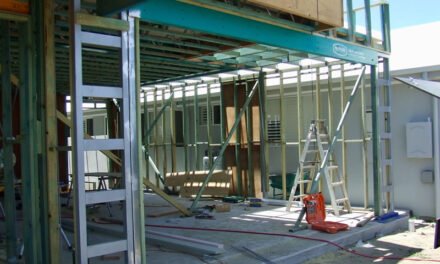As CLT becomes more readily available in the Australian market, renowned Italian machinery firm Biesse has a range of machining options, including the one behind a world-leading plant.
Construction firms around the world are looking for faster, more sustainable and cost-effective materials and processes to meet demand in Australia, Europe, the US and the UK. Mass timber is an obvious choice with its ability to slash build times and allow mid- or high-rise on ground that wouldn’t support the weight of concrete and steel. Powering this drive are some of the world’s biggest offsite construction firms (see ‘New Katerra factory’ below), and powering them are Biesse/Uniteam CLT 400 machining centres.
These are, says Biesse sales director Lee Barlow, serious machines for serious volumes. “For companies investing in this technology, it’s all about production flow,” he says. “A billet of CLT is processed through the machine then flows off the end to another workstation so they can fit all of the hardware while they’re machining another billet. The next panel is following directly, a metre or two behind.”
For basic panels that require trimming and trenching with a few fittings, the job can take as little as eight minutes – thanks to its powerful 50kW dual spindles the CLT 400 can cut header or footer plates in a single pass. Even complex panels with multiple cutouts and fittings take only 25-30 minutes, and the machine can handle panels up to 400mm thick, 3.6m wide and 20m long.
Positioning systems and reference stops make sure each panel is aligned perfectly on the machine. Whether panels are flowed in from an infeed or craned in using a pop-up, pop-down aligning system to reference, a scanner and camera detect the alignment and automatically correct fine machining operations to match the orientation.
“You can use this machine as a complete standalone,” says Barlow. “The panel just comes off the CNC as a finished product and the customer picks it up with a crane from there. The unit machines all the fixings and everything else, so the client can add their fixing bolts and then lift it.”
Up to 48 tools are available within the machine and the dual spindles can work together for single-pass, double-sided cut, or cutting independently or with one changing tools while the other cuts. The mobile bridge that houses the machining units travels down the work table on rigid rails, removing vibration and ensuring perfect end products. Lengths can be customised to need.
Easy integration
It’s a big machine, but it’s an easy fit into established fabrication processes. “We work off industry standard BTL format files,” Barlow says. “The CLT 400 integrates cleanly with all the main CAD programs – Fusion 360, ArchiCAD… Or we can customise inputs to work directly with specialist third-party software.”
A dual-monitor system allows the user to manage the CNC functions at the same time as viewing and managing CAD/CAM functions. “We can also provide design panel nesting with the machine,” says Barlow, “so we can completely design the panels for the customer and optimise them for the machine as well, if that’s wanted.
“For example, say the machine is capable of cutting to 14m x 3.6m, but you need three separate billets for the construction requirements. We can cut those three smaller walls or ceiling panels from the large billet. They just need to work within the confines of the rollers on the table itself. The machine can run a simulation to show whether or not something will work and show you on the interface.”
The software also optimises cutting small pieces, taking note of use and appearance requirements to re-purpose what might otherwise be one-tonne scrap pieces of CLT.
Dust is minimised with large individual CNC-controlled dust hoods around the tooling. A vacuum extraction system and under-table conveyor are hard-ducted to a waste disposal and additional contained dust-sweeping systems can be incorporated, such as a unit on either outer side of the machine at ground level. Barlow says, “We have a lot of options for this, because we know the value to workers and to the plant of keeping the air as clean as possible.”
Smaller starts
Not every company is Katerra-sized. In Australia, the offsite panelised market is still maturing. But with XLam and Timberlink producing CLT and CLTP Tasmania coming online with hardwood CLT, plus New Zealand’s Red Stag also making small billets, the local supply chain is strengthening, as is demand, and the number of fabricators who are working in this area is steadily growing.
“There’s not a lot of machinery in this country yet to machine that,” Barlow says. While it all means a lot of opportunity, he recognises that a big investment isn’t what every company wants.
“If you’re looking at smaller panels, then for a 1200mm-wide billet, which is usually up to 200mm, often 150mm, we have the Uniteam CK machine. We use the same machine for glulam beams and LVL-type production, which is easily managed with a machine like that. And if you’re going down to 600mm, then we can do 400mm deep on that same machine, as the CK can manage deeper on a narrower billet.
“So if you’re wanting to start down the path to billet work for light industrial and domestic construction, you could absolutely manage it with the lower-specced machines and then do some very good engineered beams with that machine, too. It’s a real workhorse with many of the same machining operations and positional accuracy features on the larger units.”
The Uniteam CK uses a vertical and horizontal clamping system to ensure every piece is precisely aligned and held without movement during machining. A pre-loading system means multiple elements can be positioned, so the machining centre is continuously fed.
While the pieces move through the machine in this unit, unlike the CLT 400, the machine can still cut all six faces of a piece in a single pass. Up to 20 tools and aggregates are held in a central magazine that allows for rapid tool changes. The two working units operate together to handle most popular cuts, using a similar software package and dual-screen interface to Biesse’s full machining centres.
For people with bigger plans, Barlow says to make sure you factor in all the challenges in the Australian marketplace. “If you’re wanting to focus on CLT and to grow, then it’s a case of working out what you can transport safely in the country on a truck. Typically, what I’ve seen is up to 14m long in the 3.6m-wide billet. The CLT 400 will get you up to the old 12-foot-tall wall.”
He worries, though, that current supply issues might put a handbrake on the sector. On the other hand, the Biesse machines are already suited to local species from the local CLT suppliers as they move into full production. “In terms of machining, it’s just feeds and speeds we need to consider when we’re looking at different timber feedstock, the weights we can usually manage with little concern. The tooling is pretty much the same, it’s just cutting speeds. You wouldn’t need to change anything from the machine you had.”
Slowly but surely, mass timber is changing the face of construction. And, Barlow adds, sometimes in unexpectedly personal ways: “The hotel that we stay in when we visit Pesaro in Italy, where our head office is located, is actually a CLT building that was built on one of our machines.”
For more, visit www.biesse.com/au/wood and www.katerra.com
New Katerra CLT Factory Goes Big with Biesse/Uniteam
Biesse and Katerra talk about the experience of installing two CLT machining centres at Katerra’s new factory.
There’s no doubt the new Katerra factory in Spokane Valley, WA has a need for speed. The company created this amazing facility in about three years, start to finish. It officially opened in September 2019 and proceeded to power up its secret weapons: two fast and furious Biesse/Uniteam CLT 400 machining centres to process Cross-Laminated Timber (CLT) panels.
According to Katerra Manufacturing Process Engineer Cory Frasheski, the Uniteam machines are crucial to the factory’s claim to fame: turning out the biggest CLT panel ever made. It’s not just mass timber, it’s massive CLT – 12-feet, 2-inches by 60 feet long (3.7×18.29m), the largest free-span CLT.
“Each panel’s sheer size means we can do a building in fewer panels,” Frasheski said. “Large panels also enable us to move more product with less shipping cost. They are ideal for our floor systems and really support our desire to be a vertically integrated company, from design to installation and construction.” In addition to floor systems, the Katerra team feeds lumber packs into the machines to produce CLT panels for ceiling and wall systems, efficiently and effectively creating full building packages.
The Uniteam machines also support two other Katerra product advantages: precision and quality. Frasheski said customers tell them they make some of the best-looking CLT they have ever seen. “We really focus on taking each individual board and thoroughly analyzing it, down to very tight geometric tolerances. Such precision means we can really squish those boards together and take out any gaps. As a result, our wood panels look more like a solid surface than boards pressed together.”
All Automation, All the Time
The Katerra factory has zero manual processes. Everything from lumber qualifying all the way up through lay-up — the process that puts lumber together with adhesive — is done through automation. “It’s hands-off, a lot safer,” Frasheski said. “You don’t have to be involved in any process physically — machines do the brunt of the work. We envision a future for our factory that also relies on artificial intelligence. We have a long road to travel to become a technology company producing lumber, but we already have a good start to it,” he said.
The plant had one other CNC at the factory start-up, but they could not wait to get the extra capacity the Biesse/Uniteam machines would bring. “At this early stage, the machines are running far from full capacity. But to see how fast they can be, we’ve done testing that assumed a panel coming in had to be out as fast as possible. Testing what the machine could do at full capacity really blew us away! The speed, accuracy, and the overall usability are exceptional. Our programmers love it. Our operators love it. And we all have a good time running our amazing machines,” Frasheski said.
The Katerra team can’t say enough about the exceptional features and capabilities of their Biesse/Uniteam machines:
Dual Spindles: “The machine is configured with independent dual spindles, so while we are cutting, we are changing tools for our next cut. The lag time for process changeover is practically eliminated.”
Process Speed: “When we are squaring up our large panels, we can use both spindles at the same time. Having the ability to dual-cut panels slices our processing time by more than half.”
Cool to Watch: “The spindles are always moving, going back and forth. The way they work together is so cool.”
Spindle Speed: “The motors are three times as powerful as our other CNC.”
Quality: “We love the quality of the machine, the way it moves and functions. It’s so smooth and seamless.”
Service: “The service has been the best I’ve seen on any machinery in this entire facility. I get a response from Biesse’s service department within 1-2 hours, and they can remote into the machine and tell me how to fix it that same day. Other companies keep us waiting up to 3 or 4 days before we even get a response.”
Future capability: “We have the ability to go all the way up to a 9-ply.
Image: The 18m-plus panels are trimmed, trenched and cut as the CLT 400’s bridge moves over them.

